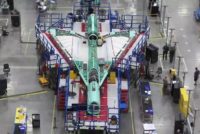A new generation of supersonic aircraft could dramatically change commercial flight. While the basic technology has been around for decades, it’s been plagued by noise issues. Due to sonic booms, supersonic jetliners are unable to fly over land.
A team of aerospace engineers at Lockheed Martin Aeronautics Co. and NASA believe they have a solution. They’re developing a new type of supersonic aircraft that will reduce sonic booms to a gentle thump.
The long-term goal is to establish an acceptable commercial supersonic noise standard to overturn current federal regulations that ban commercial supersonic travel within U.S. air space.
Engineers at Lockheed Martin’s Skunk Works in Palmdale, CA, recently started to design and assemble a Low-Boom Flight Demonstration aircraft. The piloted X-59 QueSST plane will cruise at 55,000 feet at a speed of 940 mph. Instead of a traditional sonic boom, the supersonic aircraft will create a sound that’s about as loud as a car door closing.
“This [will] open the door to an entirely new global market for aircraft manufacturers, enabling passengers to travel anywhere in the world in half the time it takes today,” claims Jaiwon Shin, associate administrator for aeronautics at NASA. “The key to success for this mission will be to demonstrate the ability to fly supersonic, yet generate sonic booms so quiet people on the ground will hardly notice them, if they hear them at all.
“Current regulations, which are based on aircraft speed, ban supersonic flight over land,” explains Shin. “With the low-boom flights, [we] intend to gather data on how effective the quiet supersonic technology is in terms of public acceptance by flying over a handful of U.S. cities, which have yet to be selected.”
“Today, one of the reasons we can’t commercially fly supersonically is because of the environmental impacts that come with flying at high speeds,” adds Peter Iosifidis, Low-Boom Flight Demonstrator project manager at Lockheed Martin Skunk Works.
“To achieve reductions in supersonic transportation airport noise, a totally new kind of propulsion system must be developed,” says Iosifidis. “[This requires] new techniques for low noise jet exhaust, integrated fan noise suppression, airframe noise suppression and computer customized airport noise abatement.”
Iosifidis and his colleagues are developing a 94-foot-long aircraft equipped with a 30-foot-wide delta-shaped wing. It will have a fully-fueled takeoff weight of 32,300 pounds. The jet will be propelled by a single General Electric F414 engine—the same type of power plant used in F/A-18E/F jet fighters.
To dissipate shock waves and generate a low noise footprint, the X-plane will feature a uniquely-shaped fuselage.
“Shock waves from a conventional aircraft design coalesce as they expand away from the airplane’s nose and tail, resulting in two distinct and thunderous sonic booms,” says Shin. “But, [the X-plane’s shape will] send those shock waves away from the aircraft in a way that prevents them from coming together in two loud booms.
“Instead, the much weaker shock waves will reach the ground still separated, which will be heard as a quick series of soft thumps,” Shin points out.
“There are few challenges from a manufacturing perspective, because no new materials or manufacturing technologies are being used to produce this X-plane,” adds Iosifidis. “There are no new subsystems, complex subsystems or subassemblies being developed.
“However, the aircraft design is such that there is no natural forward visibility for the pilot, so we are using a commercially available forward vision system that is mounted on the nose landing gear door to give the pilot full visibility,” says Iosifidis. “The system is not complex, but it is not typically used on aircraft.”
The Low-Boom Flight Demonstration aircraft will be ready to fly in three years. Beginning in mid-2022, NASA will fly the X-plane over select U.S. cities and collect data about community responses to the flights.




